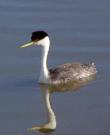Isolated case of avian flu in Spain?

Spanish Authorities Say Bird Flu Case Is Isolated One
Main Category: Bird Flu / Avian Flu News
Article Date: 08 Jul 2006 - 11:00am (PDT)
Agricultural authorities in Avala, Spain, say the H5N1 infected Great Crested Grebe is an isolated case and that people should not panic. They stressed it is just a ‘veterinary problem' and not one people should be unduly concerned about.
The Spanish Ministry of Agriculture has implemented a 3 kilometre no poultry or bird hunting zone around the area where the dead bird was found. Heightened monitoring is also taking place within a ten mile radius of the area.
The bird was found nine days ago and no other infected cases have been identified - this is after extensive monitoring and testing of many samples, say authorities.
About the Great Crested Grebe
Called Podiceps Cristatus in Latin, the Great Crested Grebe is a water bird, a member of the grebe family. It is commonly found in marshes and freshwater lake areas throughout Europe and many parts of Asia. Where winters are more severe it will migrate, otherwise it is a resident bird.
Like all grebes, it has a formidable mating display. The bird nests on the banks of lakes or rivers. This is because it is not a good walker and needs to be near water. It is not uncommon to see the striped young being carried on the mother's or father's back. Two eggs are usually laid each season.
It has a wing span of about 60cm-70cm and is about 50cm long. It hunts for fish and other aquatic creatures and will often pursue its prey underwater.
The Great Crested Grebe is white in the winter and has beautiful head and neck decorations in the summer. It has a pink bill.
In the UK it was hunted for its head plumes in the 19th century and nearly became extinct as a result. The near-extinction of the Great Crested Grebe in the UK brought about the creation of the Royal Society for the Protection of Birds (RSPB).
It is of great concern to the RSPB and other bird protection organisations throughout the world that measures taken to protect humans from bird flu are thoughtfully balanced so that the well-being of wild and domestic birds are taken into account.
Written by: Christian Nordqvist
Editor: Medical News Today


0 Comments:
Post a Comment
Subscribe to Post Comments [Atom]
<< Home